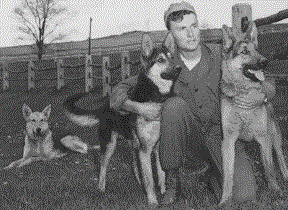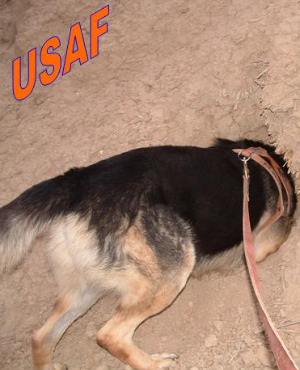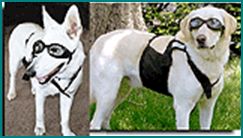|
Military Working DogsAccording to the Military Working Dog Foundation, Inc. shortly after the attack on Pearl Harbor, the American Kennel Club and a new group calling itself "Dogs for Defense" mobilized dog owners across the country to donate quality animals to the Army. These dogs were credited with saving numerous soldiers in combat.

After completion of basic training with their soldier dog handlers each dog went through specialized training in one of the following areas:

Returning Dogs to Civilian LifeAt the end of the war the dogs were sent to a reprocessing section to rehabilitate them for civilian life. The dogs were taught that humans were friendly. Adoption of Military Working DogsThe mission of the Military Working Dog Foundation is to assist the Department of Defense Military Working Dog Center in finding suitable homes for military working dogs that become available for adoption because they are no longer capable of performing their military duties. These dogs must be placed with persons capable of properly caring for them or with law enforcement agencies that have a special requirement for a trained K-9. To request an official application for a military working dog adoption, please use the form provided on the following page. Although these dogs have been trained as working military dogs, they are not intended to be used for home protection. And if you can, please make a donation to help care for these dogs until a good forever home is found.
According to the DOD, the application for adopting one of the retired dogs seeks basic information about other pets and children in the household to ensure that the right fit is found so the dog is properly cared for. Because of the high demand for the retired dogs, prospective adopters may be on a waiting list for 2-3 months. Eligibility requirements include suitability testing, a veterinary screening, eligible home location and required paperwork completion. MWD adoption officials consider such factors as children, other dogs in the home, and prior handler experience when determining placement for a dog. Not all retired military dogs will be suitable for adoption as they've been trained to be aggressive and some may not be suitable as family pets. Dogs that don't complete the training to become military working dogs need homes too. Out of 350 dogs, approximately 100 will be trained, and of those that begin the training, about 20 percent of them do not complete the training. Some of these dogs will go on to work with police departments or as service dogs but many will need to go to private homes. Military Puppies Need Foster HomesAs the need for detection dogs has increased, so has the need to breed more dogs, and in turn the need for foster homes for these soon to be military working dogs. Lackland Airforce Base in Texas operates a breeding program in support of the DOD working dog program. Volunteer foster homes are needed for puppies from 12 weeks to 6 months of age before the puppy begins military training. To be eligible, you must live within two hours of Lackland Air Force Base. If interested you may call 210-671-3686 or email 341TRSPP@us.af.mil Providing for Military Working Dogs OverseasAnd if you'd like to help the dogs while on duty in Iraq and other war zones, a very special organization, Military Working Dogs, Cooling Vest Project provides these special dogs their own equipment including: Chilly Dog Vests - prior to the dogs being equipped with these cooling vests, the dogs were only capable of working an hour to an hour and a half before experiencing heat exhaustion. Doggles - to protect a dog's eyes from the blowing sands. Muttluks - for the dog's feet to protect them from the hot sand and asphalt, which is melting in the 140 plus degree temps and sticks to their feet, causing burns, and not allowing them to dissipate their extra body heat since dogs “sweat” through their feet. Mutt Muffs - to protect their ears when transported by helicopter. FURminator - a comb to keep the dog's coat in top shape. Collapsible lightweight water bowls - can be used for both food and water and allows no water to be wasted. A toy for downtime! $400 provides for the purchase of one cooling vest, two cool packs, Doggles, Muttluks, Mutt Muffs, FURminator a collapsible water bowl, toy, and reward article. When they can, this organization also provides extendable leashes, harnesses, tracking equipment, and sturdy storage containers for the dog food.

Visit their site Support Military Working Dogs to make a donation. Retired military dogs have worked to serve their country
and protect the service men and women they serve. In their retirement, they deserve the best care and treatment.
Return from Military Working Dogs to Adopt the Right Dog Homepage
|





